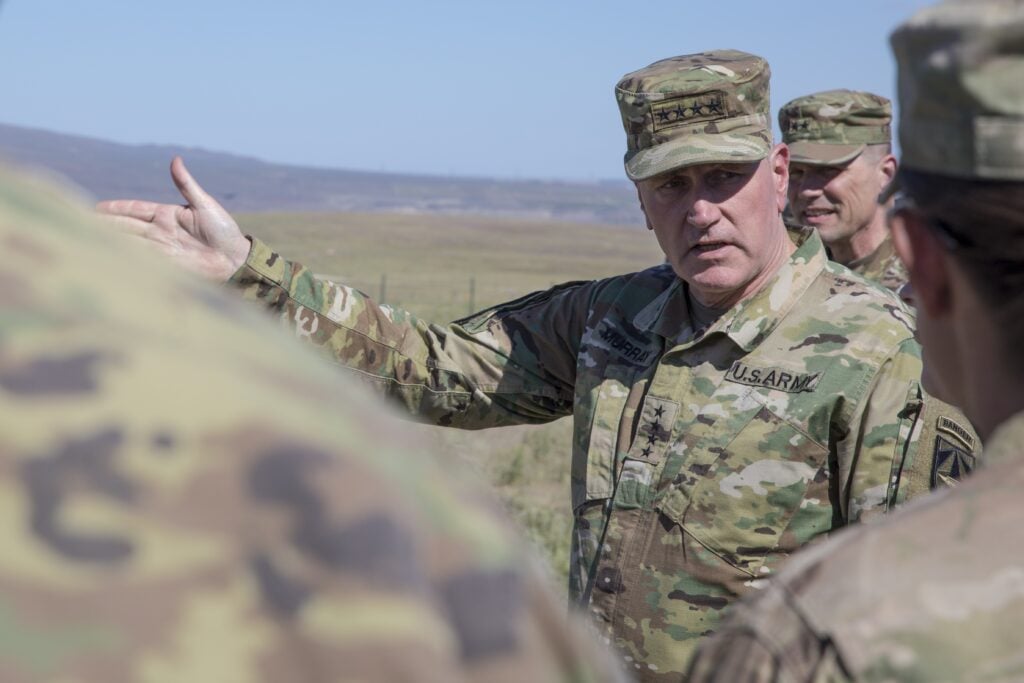
Gen. Mike Murray
WASHINGTON: It’s crunch time for Army modernization, with almost two dozen high-priority programs scheduled to field tech to combat troops in the next four years. That means a major increase in costs – from science experiments to serial production – just as the budget is dropping, with the Army widely pegged as the big bill-payer.
Now, that fiscal crunch is not a foregone conclusion, emphasized the chief of Army Futures Command, Gen. John “Mike” Murray, at the annual McAleese defense conference. It “remains to be seen,” he said, whether the Army will “be the billpayer” and help fund the Navy, Air and Space Forces.
“We’re still working through what we would call POM 23-27,” he said, referring to the budget plan for fiscal 2023-2027. “We’ve made some assumptions, some different scenarios we’re working through” – not all of which assume the Army will be subject to what the Chairman of the Joint Chiefs predicted would be a “fiscal bloodletting.”
The service has already scrubbed its own budget for tens of billions in savings to fund modernization, working through a series of grueling Night Court reviews. “We have made a bunch of hard choices, and we’re going to have to make more hard choices,” Murray said. “In many cases… it’s almost the point of being almost impossible choices.”
Regardless of the budget topline, Murray said, the Army will stick to its established modernization priorities: 35 technologies, from 1,725-mile hypersonic missiles to augmented-reality targeting goggles, that its analysis considers potential gamechangers for future conflict.
(Army jargon refers to these initiatives – many are not yet formal programs of record – as the “31 plus 4,” because 31 are overseen by Army Futures Command, but four of the highest priorities fall under the Rapid Capabilities & Critical Technologies Office).
“22 of those will deliver a capability into the hands of our soldiers within the next four years,” Murray said.
Murray didn’t list technologies, but the acting Army Secretary, John Whitley, gave some highlights in a recent speech.
“We are fielding new systems and equipment now and will continue to do so over the next decade,” Whitley said. Examples include
- FY ’21, Maneuver Short-Range Air Defense, Enhanced Night Vision Goggle-Binocular;
- FY ’22, Integrated Visual Augmentation System, Armored Multi-Purpose Vehicle, and the Integrated Air and Missile Defense Battle Command Systems;
- FY ’23, Next Gen Rifle & Squad Automatic Weapons, Mid-Range Missiles, Precision Strike Missiles, and Hypersonic Missiles; [and]
- FY ’24-FY26, the Army will begin fielding Extended Range Cannon Artillery, Mobile Protected Firepower, and Future [Tactical] Unmanned Aerial Systems.
“These aren’t far-off pipe dreams, rather capabilities that will land in our formations by FY 30,” Whitley emphasized.
The Army hasn’t modernized on this scale since the 1980s. But all of the “Big Five” weapons programs introduced back then began development during the 1970s or earlier. Work on what became the M2 Bradley began in 1967; what became the M1 Abrams began development in 1963. Why did it take so long? “It was because resources were scarce in the 70s until President Reagan came in,” Murray said.
Now, after four decades of upgrading Reagan-era equipment, the Army can’t afford to wait.
“We have to seize this opportunity to modernize,” Murray said. “We’ve been given the opportunity over the last two to three years to really get a great start towards a transformational modernization, and we can’t afford to give up on that.”






















